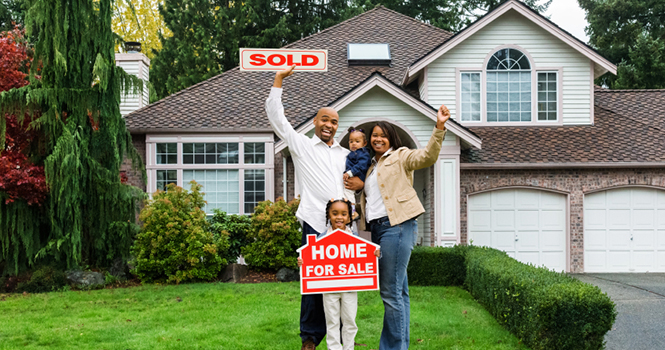Despite ongoing inventory shortages and faster price growth, existing-home sales sustained their recent momentum and moved higher for the second consecutive month, according to the National Association of REALTORS®. A surge in sales in the Midwest and a decent increase in the Northeast offset smaller declines in the South and West.
Total existing-home sales, which are completed transactions that include single-family homes, townhomes, condominiums and co-ops, rose 1.7 percent to a seasonally adjusted annual rate of 5.45 million in April from an upwardly revised 5.36 million in March. After last month’s gain, sales are now up 6.0 percent from April 2015.
Lawrence Yun, NAR chief economist, says April’s sales increase signals slowly building momentum for the housing market this spring. “Primarily driven by a convincing jump in the Midwest, where home prices are most affordable, sales activity overall was at a healthy pace last month as very low mortgage rates and modest seasonal inventory gains encouraged more households to search for and close on a home,” he says. “Except for in the West – where supply shortages and stark price growth are hampering buyers the most – sales are meaningfully higher than a year ago in much of the country.”
The median existing-home price for all housing types in April was $232,500, up 6.3 percent from April 2015 ($218,700). April’s price increase marks the 50th consecutive month of year-over-year gains.
“Thanks to a two-month streak of increases, the pace of existing home sales is now in line with the seasonally adjusted pace of sales at the beginning of the year and 6 percent higher than last year,” says realtor.com chief economist Jonathan Smoke. “The April gain over March is consistent with the average gain over the last 5 years, which shows that momentum is continuing from a strong start to the year as we approach the peak months for sales.”
Total housing inventoryat the end of April increased 9.2 percent to 2.14 million existing homes available for sale, but is still 3.6 percent lower than a year ago (2.22 million). Unsold inventory is at a 4.7-month supply at the current sales pace, up from 4.4 months in March.
“The temporary relief from mortgage rates currently near three-year lows has helped preserve housing affordability this spring, but there’s growing concern a number of buyers will be unable to find homes at affordable prices if wages don’t rise and price growth doesn’t slow,” adds Yun.
According to Freddie Mac, the average commitment rate for a 30-year, conventional, fixed-rate mortgage fell from 3.69 percent in March to 3.61 percent in April, which is the lowest since May 2013 (3.54 percent). The average commitment rate for all of 2015 was 3.85 percent.
“April’s rise continues an upward trend in the rate of home purchases,” says Quicken Loans Vice President Bill Banfield. “Despite rising prices and a shortage of listings in the many markets, buyer demand continues to hold strong. The year-over-year growth is encouraging to see as further proof that the economy continues to gain steam.”
Properties typically stayed on the market for 39 days in April (47 days in March), which is unchanged from a year ago but the shortest duration since June 2015 (34 days). Short sales were on the market the longest at a median of 120 days in April, while foreclosures sold in 51 days and non-distressed homes took 37 days. Forty-five percent of homes sold in April were on the market for less than a month – the highest since June 2015 (47 percent).
“Looking ahead, with demand holding steady and supply levels still far from sufficient, the market for entry-level and mid-priced homes will likely continue to be the most competitive heading into the summer months,” says Yun.
The share of first-time buyers was 32 percent in April, up from 30 percent both in March and a year ago. First-time buyers in all of 2015 also represented an average of 30 percent.
At last week’s 2016 REALTORS® Legislative Meetings & Trade Expo, U.S. Housing and Urban Development Secretary Julian Castro announced beneficial changes to FHA condo rules, which could help many first-time buyers, are moving forward and are currently at the Office of Management and Budget for review.
“Secretary Castro’s update that the condo rule changes are in their final stages before implementation received great applause from REALTORS® both at the forum and throughout the country,” says NAR President Tom Salomone, broker-owner of Real Estate II Inc. in Coral Springs, Florida. “To ensure that purchasing a condo increasingly becomes a viable and affordable option for first-time buyers, NAR supports the ongoing efforts to eliminate unnecessary barriers holding back condo sales. We hope that progress on this condo rule means we’ll see some much-needed changes in the near future.”
All-cash sales were 24 percent of transactions in April, down from 25 percent in March and unchanged from a year ago. Individual investors, who account for many cash sales, purchased 13 percent of homes in April (matching the lowest share since October 2015), down from 14 percent in both in March and a year ago. Sixty-nine percent of investors paid cash in April.
Distressed sales– foreclosures and short sales – declined for the second straight month to 7 percent in April, down from 8 percent last month and 10 percent a year ago. Five percent of April sales were foreclosures and 2 percent were short sales. Foreclosures sold for an average discount of 17 percent below market value in April (16 percent in March), while short sales were discounted 10 percent (unchanged from March).
Single-family and Condo/Co-op Sales
Single-family home sales inched forward 0.6 percent to a seasonally adjusted annual rate of 4.81 million in April from 4.78 million in March, and are now 6.2 percent higher than the 4.53 million pace a year ago. The median existing single-family home price was $233,700 in April, up 6.2 percent from April 2015.
Existing condominium and co-op sales jumped 10.3 percent to a seasonally adjusted annual rate of 640,000 units in April from 580,000 in March, and are now 4.9 percent above April 2015 (610,000 units). The median existing condo price was $223,300 in April, which is 6.8 percent above a year ago.
Regional Breakdown
April existing-home sales in the Northeast climbed 2.8 percent to an annual rate of 740,000, and are now 17.5 percent above a year ago. The median price in the Northeast was $263,600, which is 4.1 percent above April 2015.
In the Midwest, existing-home sales soared 12.1 percent to an annual rate of 1.39 million in April, and are now 12.1 percent above April 2015. The median price in the Midwest was $184,200, up 7.7 percent from a year ago.
Existing-home sales in the South declined 2.7 percent to an annual rate of 2.19 million in April, but are still 4.3 percent above April 2015. The median price in the South was $202,800, up 6.5 percent from a year ago.
Existing-home sales in the West decreased 1.7 percent to an annual rate of 1.13 million in April, and are 3.4 percent lower than a year ago. The median price in the West was $335,000, which is 6.5 percent above April 2015.
“We’ve now seen 44 straight months of tight supply. In these conditions, home values have strong support, but potential buyers will continue to face challenges finding a home for sale that meets their needs,” says Smoke. “The biggest challenge to prospective buyers is tight supply, and that’s why we’re seeing the age of inventory drop dramatically. At the same time, we estimate that sales to first-time buyers are up 11 percent so far this year, and they comprise the largest source of this year’s growth in sales.”
For more information, visit www.realtor.org.











